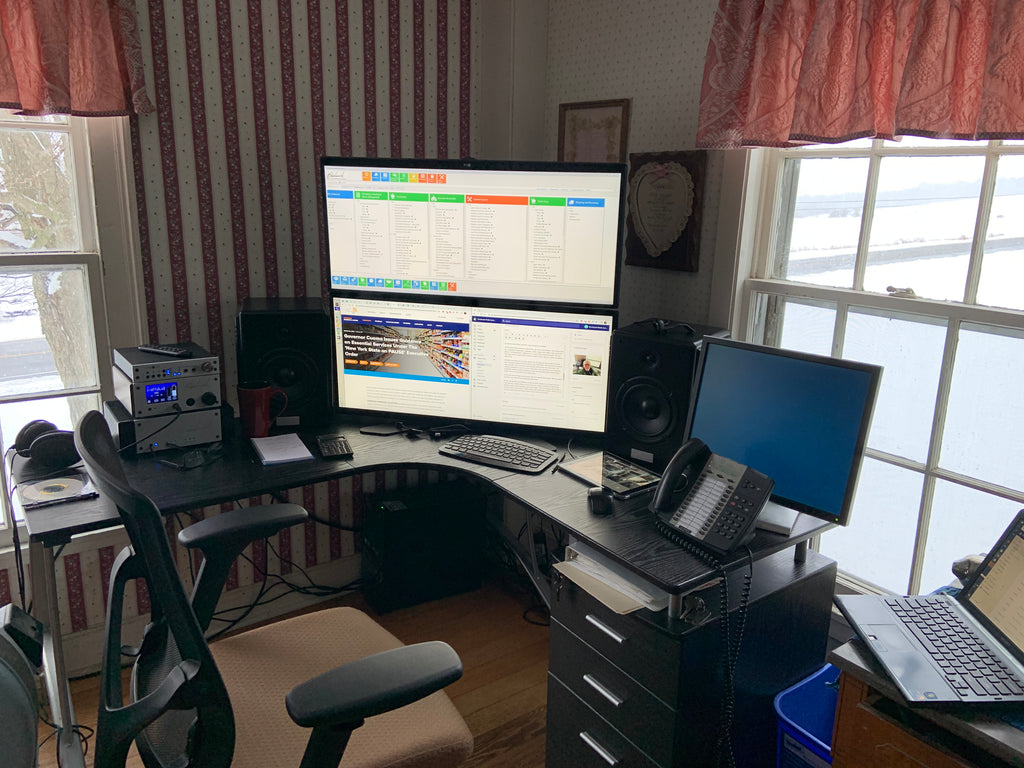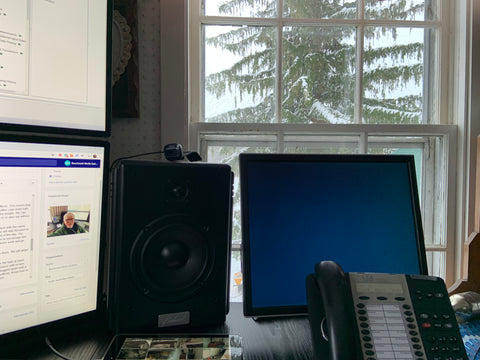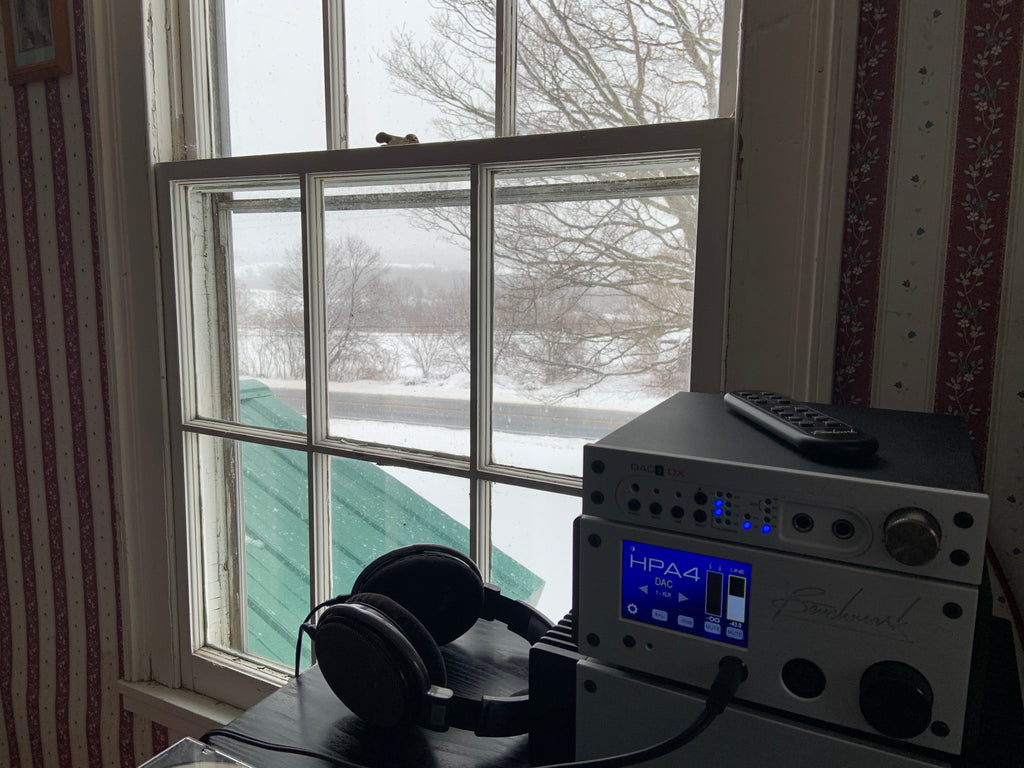Thanksgiving Special - Buy one component* and get additional components at 25% off! Offer ends tomorrow at midnight.
Thanksgiving Special - Buy one component* and get additional components at 25% off! Offer ends tomorrow at midnight.
COVID-19 ... Don't just survive!
by John Siau March 23, 2020

A Week Ago, Life was Normal
How fast things can change!
This application note will be a departure from normal. I will make a few observations about the current situation and then look at the nuts and bolts of how we reconstructed our operations in less than 48 hours. Benchmark is 100% operational, but nothing looks the same as it did last week.
It is March 23, 2020
It is March 23, 2020 and we are currently battling the worldwide COVID-19 pandemic. It has found its way to New York State and our State and Federal governments have declared a state of emergency. New York State has been declared a federal disaster area and our Governor has ordered that most businesses send their entire staff home. This seems to be a serious situation and things are changing quickly. Life is anything but normal!

Today is the First Day in our New Offices
Like everyone else at Benchmark, this is my first day in my new home office. In less than 48 hours, Benchmark has transitioned from a traditional work environment to one where our entire office staff works from home. We are connected by computer networks, video conferencing, email, messaging and VOIP telephones. Most of us even have our Benchmark audio components set up so that we can listen to music and conduct collaborative sessions without struggling with poor audio. In the short term, our new offices are the new normal.

In our headquarters, I could look through my office windows and see most of the other offices and a portion of the manufacturing floor. Now I am looking out my windows overlooking the snow-covered fields on our farm.
"Essential Businesses"
As I look around our community, restaurants, schools and churches are all closed but the liquor stores are open. It turns out that liquor stores are classified as "essential businesses". Who knew?
In New York State, day care centers and public transportation have also been classified as "essential". Nevertheless I don't think I would want to be in either of those places! When asked about the reasons for keeping public transportation open, Governor Cuomo replied "people need a way to get to the hospital". Wow! Stay well and stay off of the trains and buses!
The grocery stores are open and are doing record business. It is a good time to be in the grocery business. They are having a hard time restocking quickly enough to meet the record demand. Some items are hard to find. Who would have guessed that the hottest item would be toilet paper? There are definitely some people who will not need to buy any toilet paper for the next few years! The bright side is that some of the people who were laid off by restaurants are being hired by the grocery stores. Every crisis has winners and losers.
Prognosis
As we look around the world China claims they are returning to "normal", Singapore seems to have escaped the worst, but Italy is deep in the middle of a very serious crisis. Will the USA be the next Singapore or the next Italy? Time will tell. Things are not good in New York City, but we are doing well here in the rural areas of the state.
Most members of the medical community are taking a very cautious approach and are warning that this is very serious. A minority are saying that this is no worse than a bad flu and that we are victims of incomplete statistics. Again, time will tell.
The Life and Death Choice ... Option 1 or Option 2?
It is clear that we need to find the proper balance between over reacting and failing to react. We seem to be faced with a difficult choice between two bad options. If we over react we may kill the economy but live to tell about it. On the other hand, if we fail to react, we will die and the economy won't matter.
If someone tells you there are two options, always pick option 3!
As an engineer I try not to choose the lesser of two evils. If all of the choices are bad, I keep looking for a solution. More often than not, we can find a solution that makes us stronger, better, and more resilient.
So What Is Option 3?
Stop asking yourself how you will survive!
Ask yourself how this crisis will make you better.
To do this, ask yourself the following questions:
- How can this crisis make my company stronger?
- How can this crisis make me a more productive employee?
- What do we need to stop doing?
- What do we need to start doing?
For Benchmark these questions are answered as follows:
- We will be fully functional without the use of our main offices. This means that our computers, telephones, networks, desks, chairs and coffee cups exist in both places. We have full redundancy and both sets of offices are equally equipped. Nothing has to move other than the people. We can step back into our main offices and be ready to work. The key is to be able to step in or step out without setup time. Earlier this year we eliminated set-up tasks from our production line. Each work station is fully equipped and fully stocked for a specific task. Anyone can sit down and begin the task immediately. We are now applying this principle to our offices.
- When we walk into our home offices we will approach them with the same level of professionalism that we have in the main office. We will stay focused on work and then step out of the room and go home at the end of the day. Our salaried employees clock in and out of our time clock system to encourage this separation between work and family. It also lets us see which co-workers are working. Work hard, keep regular hours, and then leave work and go home! Don't try to do both at the same time.
- We will not do things just because we have always done them. We will adapt and find new ways of accomplishing daily tasks.
- We will pick the most efficient communication method for the task at hand. This may be a simple phone call or it may be a video conference with screen sharing. Keep communication quick and simple. Don't get bogged down with a bunch of fancy tools when a quick phone call would have sufficed. Know how to use the fancy tools but only use them when they are required.
The Nuts and Bolts of a Rapid Exit
- We cheated! We had a head start. This is essential. Give yourself an unfair advantage.
- We had an entire set of duplicate VOIP telephones that were stored up as part of our disaster plan.
- We had a few extra computers, monitors, desks and chairs. Last week we purchased what we didn't have. The new computers arrived on Friday and were deployed on Saturday.
- By Saturday afternoon, most home offices were ready to go. All were ready by Sunday night.
- In a few cases, we borrowed equipment from some offices. This is being replaced so that the home offices can stay intact when this is all over or partially over.
- It is important to remember that the equipment is much cheaper than your time. Don't be afraid to replicate everything. Full redundancy is the way to go.
Here is a photo of Michael's home office:

Technical Details
We have redundant internet connections at the main office. These connections come from two different providers and enter opposite ends of the building from two different streets. We use redundant fail-over firewalls, switches, and servers. We have on-site and off-site backups of every computer on the network (not just the servers). Even the off-site computers are backed up daily. The goal is to minimize down time and maximize our resiliency to withstand the unexpected.
Our VOIP phones can be plugged into the internet almost anywhere in the world and they act as if we are in our main office. We can see who is on the line and we have all of the exact features that we have when we are in the main office. Our phones ring both places at the same time.
Several of us have iPads on our desks that show all of our security cameras. This keeps the remote workers in touch with what is happening in the main office.
An internet connected doorbell, electronic lock and intercom system allows us to accept deliveries without being at the office.

Essential Audio Equipment
We all have headphones in our home offices so that we can have collaborative sessions without the usual echo and feedback problems. Headphones are essential. They can also provide some isolation from noise and distractions.
Most of us have Benchmark DAC3 D/A converters connected to our computers. These provide top-quality output to our HPA4 headphone amplifiers and AHB2 power amplifiers. These Benchmark components are everyone's favorite part of our home offices. I am streaming music from Tidal using a Roon server. We are not just surviving!
Time to Leave the Office
It is now time to quit for the day. I am hitting the time clock and walking out of my home office for the day. It is a very short commute, one stairway and about 10 steps. I am going home to spend some time with my family and I won't be back until tomorrow morning.
Stay safe and don't just survive. Figure out how to be a winner not just a survivor!
Also in Audio Application Notes

How Loud is the Distortion from Your Power Amplifier?
by John Siau August 08, 2025
Would you put a Washing Machine in your Listening Room?
If the answer is no, you may be surprised to discover that the distortion produced by your power amplifier may be louder than the noise produced by a major appliance.
Don't believe me? Take a look at Stereophile's test reports:
We selected 7 power amplifiers from Stereophile's top list of recommended amplifiers.
We took Stereophile's "THD+N vs. Power" plots for each, and replotted the data in a format that shows the loudness of the THD+N at the listening position.
The results are shocking!
Amplifier THD+N is louder than expected!
The distortion from your amplifier may be louder than a washing machine on the spin cycle, or it may be totally silent. How does yours perform? The answer is hidden in Stereophile's THD+N plots.
This application note reveals the hidden truth:
"The Distortion from your Power Amplifier may be Louder than a Washing Machine!"
I know, it sounds crazy, but this is what the measurements show!

Interpolator Overload Distortion
by John Siau November 20, 2024
Most digital playback devices include digital interpolators. These interpolators increase the sample rate of the incoming audio to improve the performance of the playback system. Interpolators are essential in oversampled sigma-delta D/A converters, and in sample rate converters. In general, interpolators have vastly improved the performance of audio D/A converters by eliminating the need for analog brick wall filters. Nevertheless, digital interpolators have brick wall digital filters that can produce unique distortion signatures when they are overloaded.
10% Distortion
An interpolator that performs wonderfully when tested with standard test tones, may overload severely when playing the inter-sample musical peaks that are captured on a typical CD. In our tests, we observed THD+N levels exceeding 10% while interpolator overloads were occurring. The highest levels were produced by devices that included ASRC sample rate converters.

Audiophile Snake Oil
by John Siau April 05, 2024
The Audiophile Wild West
Audiophiles live in the wild west. $495 will buy an "audiophile fuse" to replace the $1 generic fuse that came in your audio amplifier. $10,000 will buy a set of "audiophile speaker cables" to replace the $20 wires you purchased at the local hardware store. We are told that these $10,000 cables can be improved if we add a set of $300 "cable elevators" to dampen vibrations. You didn't even know that you needed elevators! And let's not forget to budget at least $200 for each of the "isolation platforms" we will need under our electronic components. Furthermore, it seems that any so-called "audiophile power cord" that costs less than $100, does not belong in a high-end system. And, if cost is no object, there are premium versions of each that can be purchased by the most discerning customers. A top-of-the line power cord could run $5000. One magazine claims that "the majority of listeners were able to hear the difference between a $5 power cable and a $5,000 power cord". Can you hear the difference? If not, are you really an audiophile?

